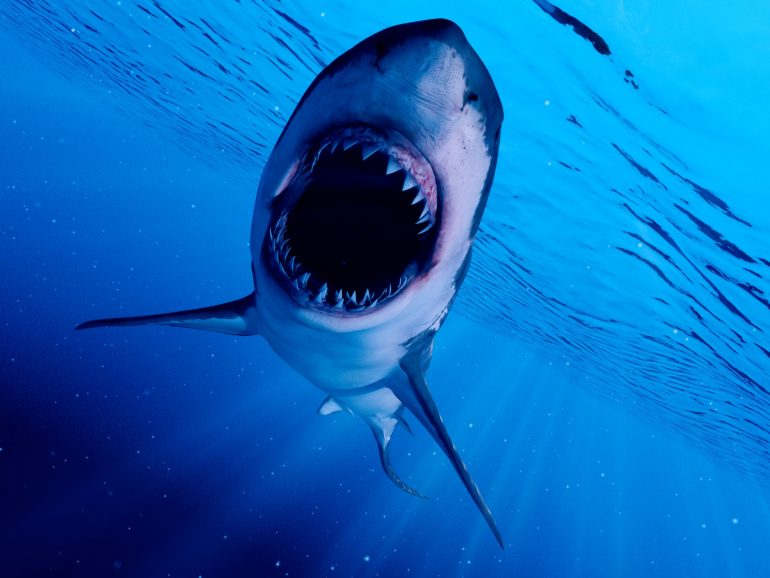The shark skeleton is one of biology’s most fascinating subjects. Sharks are the ocean’s apex predator so it’s easy to assume that they have strong bones in their tails to power through the water and equally impressive jawbones to power through their prey.
If that’s the assumption, the answer to the question ‘do sharks have bones’ is about to shock you…
How Many Bones Do Sharks Have?

A great white shark about to attack (Photo: Getty Images)
The bones that make up the human skeleton give our bodies shape, strength and rigidity. They allow us to move the way we do, they protect our vital organs and they provide the framework that connects our muscles and tissue.
So it will surprise you to know that whether it’s the great white shark, blacktip reef shark, lemon shark or even the eel-like frilled shark, the shark skeleton doesn’t contain a single bone. In fact a shark is what’s known as an elasmobranch, a category of fish that doesn’t have any bones at all.
The shark skeleton is instead made of cartilage, a much softer tissue more flexible than bone but still strong enough to do all the things a human skeleton does.
Why is a Shark Skeleton Made of Cartilage?

Young great white shark in the ocean light (Photo by James Reynolds via Getty Images)
Sharks as we recognise them today have been patrolling the oceans for around 200 million years. During this time they have evolved perfectly to suit their diet and habitat and to aid their migration and hunting habits.
Do sharks have bones has long been a fascinating question and there are very good reasons why sharks – and other members of the elasmobranch family like rays, skates and sawfish – have evolved in this way.
Cartilage is around half the density of bone and this is particularly important for sharks because unlike other fish, they don’t have a swim bladder (the equivalent of lungs in a human) to aid buoyancy and stop them sinking. Instead, they have very large livers full of low-density oils and hydrocarbons which gives them their buoyancy.
Cartilage is also much more flexible than bone which allows sharks to not only swim faster but to make exceptionally quick turns, an essential skill when pursuing prey and evading predators.
What are the Benefits of a Cartilaginous Skeleton?

A shark going for the kill (Photo by Imke Meyer via Getty Images)
If we were asking ‘how many bones does a shark have’ 450 million years ago the answer would be vastly different to today’s. The fossil record suggests that sharks probably did have bones but evolved over the course of around a quarter of a billion years into the cartilaginous predators we know today. But why?
We know that cartilage is lighter, it aids floatation and gives a shark its speed and power but there are other benefits to having a skeleton made of cartilage.
- Cartilage isn’t as hard or protective as bone so it created a thicker skin which helps prevent injury;
- It makes a sharks’ jaw more flexible and extendable. They can open their mouths much wider than if they had a rigid jawbone and it means the downward force of their bite is much faster and more powerful;
- Cartilage is softer than bone so injuries are more common. On the flipside, cartilage heals much faster than bone;
- As opposed to bone, cartilage leaves unlimited scope for growth so sharks have become some of the ocean’s biggest and most fearsome predators.
Do Sharks Have Vertebrae?

Great white shark with open jaws (Photo by Alistair Pollock Photography via Getty Images)
The simple answer to the question do sharks have vertebrae is yes. Sharks are classed as vertebrates because they have a spinal column just like a human, but there’s nothing in the definition that says it must be made of bone.
The primary role of the vertebrae is to protect the spinal cord. It is much more flexible than that of a human and this element of the shark skeleton is an essential tool in the shark’s arsenal. Because it demonstrates such flexibility, it allows energy to be stored in the vertebrae as the vertebral column bends and this in turn compresses the structures that stack to create the spinal column.
This stored energy source is released at the end of a tailbeat – scientists believe it could be upwards of 10% of the shark’s energy – which helps them to power towards – or away from – prey or predator.
In Summary: Do Sharks Have Bones?

Great white shark surfacing off the coast of Guadalupe Island Mexico (Photo by Allan Davey via Getty Images)
Sharks do not have bones but instead have a Cartilaginous Skeleton which provides strength, power and flexibility making sharks one of the most powerful species on the planet.












